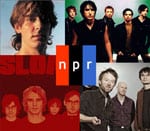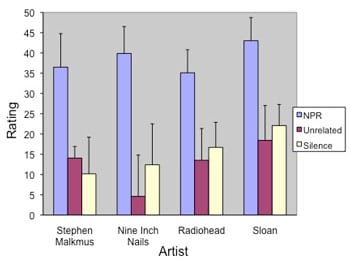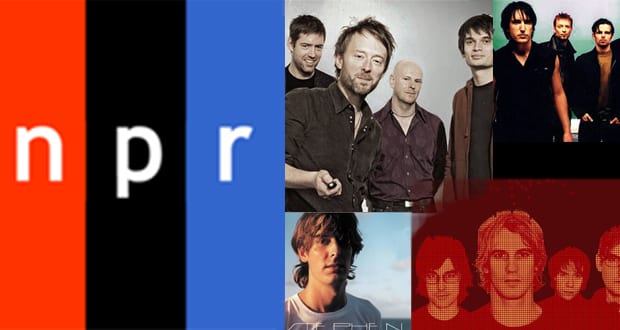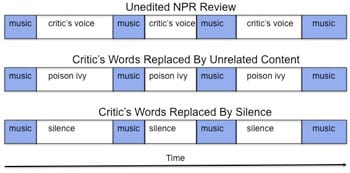Kathleen M. Silva and Francisco J. Silva
University of Redlands
 Abstract:
Abstract:
The present study examined whether music critics can influence listeners’ opinions of music or whether these critics simply reflect listeners’ opinions of music. The results showed that listening to National Public Radio (NPR) critics favorably review artists’ CDs influenced listeners’ opinions of songs from those discs. This effect was observed across four artists of varying popularity, recognition, and musical styles (Stephen Malkmus, Nine Inch Nails, Radiohead, and Sloan), across three NPR critics (Will Hermes, Tom Moon, Ken Tucker), and across songs that were and were not referenced or previewed in the reviews. These results add to and extend the generality of previous demonstrations that music critics can influence – rather than simply reflect or predict – listeners’ musical preferences.
- Citation
- Author Bios
 Kathleen M. Silva earned her PhD from Indiana University. She is currently an Associate Professor of Psychology at the University of Redlands. Her research interests include the study of how people’s musical preferences can be influenced by procedures rooted in learning theory and social psychology. Her articles have appeared in Learning and Motivation, Behavioural Processes, Teaching of Psychology, and Psychology of Music. kathleen_silva@redlands.edu
Kathleen M. Silva earned her PhD from Indiana University. She is currently an Associate Professor of Psychology at the University of Redlands. Her research interests include the study of how people’s musical preferences can be influenced by procedures rooted in learning theory and social psychology. Her articles have appeared in Learning and Motivation, Behavioural Processes, Teaching of Psychology, and Psychology of Music. kathleen_silva@redlands.edu
Francisco J. Silva earned his PhD from the University of Manitoba. He is currently a Professor of Psychology at the University of Redlands. His research interests include the study of what humans understand about physical causality. His articles have appeared in American Psychologist, Journal of the Experimental Analysis of Behavior, Learning & Behavior, and Psychonomic Bulletin & Review.francisco_silva@redlands.edu
Despite evidence that opinion leaders such as critics can influence people’s views (Cialdini, 2001; e.g., Bausuroy, Chatterjee, & Ravid, 2003), there remains doubt as to whether critics are not merely predictors (because they are a sample of a broader population) rather than causal agents of other people’s opinions (see Clement, Proppe, & Rott, 2007; Eliashberg & Shugan, 1997; Weiman, 1991). These two views, though, are not mutually exclusive. To the extent that critics’ opinions are similar to the broader population’s opinions, their reviews predict what other people are likely to think. To the extent that critics are opinion leaders, their views could influence other people, especially when someone knows little about a product or an issue or has not formed a strong opinion about the subject (Petty & Cacioppo, 1986; e.g., Lee, Park, & Han, 2008). For example, although based only on a single review and song, a laboratory experiment that examined a music critic’s ability to influence listeners’ opinions showed that participants who listened to a favorable review of a CD had a more favorable opinion of the artist’s music (K Silva & F. Silva, 2009).
The purpose of the present study was to more fully explore music critics’, in particular those broadcast on National Public Radio (NPR) in the United States, powers of persuasion. Americans consider NPR to be one the most trusted sources for information (Harris Interactive and the Public Relations Society of America Foundation, 2005). As such, one might expect that NPR critics’ power to shape – rather than merely reflect – people’s views would be considerable. In the present study, different groups of people listened to favorable NPR reviews of CDs and then rated how much they liked a song from the reviewed CD. These participants’ ratings were compared to those of participants in control groups who did not hear the reviews.
The NPR reviews were about CDs by the artists Stephen Malkmus, Nine Inch Nails, Radiohead, and Sloan. A composite description of these artists from rollingstone.com, rhapsody.com, allmusicguide.com and the reviews cited below provides a sense of their music and careers. Stephen Malkmus is a former member of the 1990s band, Pavement. His music and lyrics have been described as enigmatic and non-linear, ranging from classic rock to Dylanesque. More broadly, his music is categorized as indie-rock or alt-rock. Nine Inch Nails is the moniker for multi-instrumentalist, songwriter, producer, and arranger Trent Reznor’s industrial rock. However, the Nine Inch Nails CD used in the present study is entirely instrumental and more atmospheric than most of the music in their catalogue. Radiohead were one of the most acclaimed artists of the 1990s who continue to achieve worldwide success in the 21st century. Their expansive and sometimes challenging music resists simple description, but it is typically categorized as Brit-rock or alt-rock. Sloan is a Canadian band who is well known in their native land, but who are unknown elsewhere. Their music is broadly categorized as pop-rock or power pop, and it bears some resemblance to the music of The Beatles. Using music from artists of different musical genres and who have achieved varying degrees of success, as well as using different NPR music critics, allowed us to assess the generality of the results. In addition, we chose to use these four artists out of convenience; we had access to the CDs that were reviewed.
Method
Participants
A total of 202 students of traditional college age (18 to 21 yrs) from a liberal arts university volunteered for the study. The students received extra credit or partial course credit for their participation. A survey of the participants’ musical tastes indicated that their favorite genre of music was hip hop and rap (26%), followed by hard rock (16%), pop (11%), other (11%), alternative and punk rock (9%), classic rock (8%), country (8%), soft rock and R&B (6%), heavy metal (3%), and classical, blues, and jazz (2%). The “other” category consisted of oldies, reggae, musicals, opera, folk, and dance. Participants were randomly assigned to the groups described below.
Groups and Materials
Malkmus Groups. Group NPR-Malkmus (n = 14) listened to music critic Will Hermes’s (2008) complete review of Stephen Malkmus’s (2008a) CD, Real Emotional Trash. The 4:16 review was broadcast on July 10, 2008 as part of the NPR program, All Things Considered. Because excerpts of songs from Real Emotional Trash were embedded in Hermes’s review, it was necessary to control for any effect of these snippets by presenting these exact excerpts to two control groups. The content of the excerpts, their durations, and how they were spaced in time were identical to those in Hermes’s review. For one control group, Group Unrelated-Malkmus (n = 15), the content of Hermes’s critique (i.e., the spoken portion, the segments that were not music) was replaced with an NPR report about a pill to prevent the itch of poison ivy (Franklin, 2008). For another control group, Group Silence-Malkmus (n = 12), the content of Hermes’s critique was replaced by silence. Thus, the excerpts of the Malkmus songs used in Hermes’s review appeared for the same duration and in the same relative position for all three groups. What differed was the content between the music. Group NPR-Malkmus listened to Hermes’s complete and unedited review; Group Unrelated-Malkmus listened to a report about poison ivy between the fragments of Malkmus’s songs that appeared in Hermes’s review; and Group Silence-Malkmus heard only silence between the excerpts of music that appeared in Hermes’s review. A schematic of how the three groups differed is presented in Figure 1. The test song was “We Can’t Help You” by Stephen Malkmus (2008b). We chose this test song because it was featured prominently in Hermes’s (2008) review.
Nine Inch Nails Groups. Group NPR-NIN (n = 12) listened to Tom Moon’s (2008) complete review of Nine Inch Nail’s (2008a) CD, Ghosts. The 3:58 review was broadcast on April 14, 2008 as part of the NPR program, All Things Considered. For Group Unrelated-NIN (n = 14), the spoken portion of Moon’s critique was replaced with the NPR report about a pill to prevent the itch of poison ivy (Franklin, 2008). For Group Silence-NIN (n = 16), the spoken portion of Moon’s critique was replaced by silence. The test song was “14 Ghosts” by Nine Inch Nails (Reznor & Ross, 2008). We chose this song because no portion of it was featured in Moon’s (2008) review, thus allowing us to examine whether the effect of a review extended to music not heard in a review.
Radiohead Groups. Group NPR-Radiohead (n = 18) listened to Tom Moon’s (2007) complete review of Radiohead’s (2008a) CD, In Rainbows. The 3:58 review was broadcast on October 10, 2007 as part of the NPR program, All Things Considered. For Group Unrelated-Radiohead (n = 15), the spoken portion of Moon’s critique was replaced with the NPR report about a pill to prevent the itch of poison ivy (Franklin, 2008). For Group Silence-Radiohead (n = 20), the spoken portion of Moon’s critique was replaced by silence. The test song was “Bodysnatchers” by Radiohead (2008b). We chose this song because it was explicitly referenced and featured in Moon’s (2007) review.
Sloan Groups. Group NPR-Sloan (n = 17) listened to Ken Tucker’s (2008) complete review of Sloan’s (2008a) CD, Parallel Play. The 5:52 review was broadcast on July 30, 2008 as part of the NPR program, Fresh Air From WHYY. For Group Unrelated-Sloan (n = 16), the spoken portion of Tucker’s critique was replaced with the NPR report of about a pill to prevent the itch of poison ivy (Franklin, 2008). For Group Silence-Sloan (n = 18), the spoken portion of Tucker’s critique was replaced by silence. The test song was “The Other Side” by Sloan (2008b). We chose this song because it was featured prominently in Tucker’s (2008) review.
Figure 1. A schematic illustrating how the groups of participants differed in terms of what they listened to before listening to a test song. Three groups of participants listened to different variations of an NPR review before listening to a test song. One group listened to a complete, unedited NPR review. A second group listened to an edited version of the review in which all of the spoken parts of a review (i.e., the portions spoken by the critic) were replaced with content that was unrelated to music (a discussion about a pill to relieve the itch of poison ivy). Within this edited review, the musical portions of the original review appeared for the same durations and in the same positions. Finally, a third group listened to an edited version of the original review with all of the spoken parts of the review replaced by silence. Again, within this edited review, the musical portions of the original review appeared for the same durations and in the same positions.
Procedure and Data Analyses
Depending on the group, participants listened to an actual NPR review, an edited NPR review that consisted only of snippets of an artist’s songs interspersed with a report about a pill to stop the itch of poison ivy, or an edited NPR review that consisted of these same snippets interspersed with silence before listening to a test song as per above. On a datasheet provided by a researcher, the participants used a visual analogue scale (see Wewers & Lowe, 1990) to rate the test song once it finished playing by drawing a vertical line across a 180-mm horizontal line anchored by a negative sign (–) at the left end and a positive sign (+) at the right end. The numeral zero (0) was at the midpoint of the line. The location at which the vertical line crossed the horizontal line indicated a participant’s rating of the song. Thus, a vertical line drawn 20 mm to the right of the zero was recorded as a rating of +20; a vertical line drawn 13 mm to the left of the zero was recorded as a rating of –13. Because there were 90 mm on each side of the 0 point, the highest possible rating was 90. After the participants indicated their rating, they were asked to indicate (a) if they recognized the artist profiled in the review (experimental groups) or the artist they had just listened to (control groups), (b) if they recognized the test song they listened to (all groups), and (c) to indicate their favorite type of music from a list of categories (all groups).
Omnibus analyses were conducted using one-way analyses of variance (ANOVA). Fisher’s Least Significant Difference tests were used for all post hoc analyses. Mean differences of p < .05 were considered statistically significant.
Results
Figure 2 shows that the participants liked a song more if they first listened to an NPR review that was related to that song. Group NPR-Malkmus’s mean rating of “We Can’t Help You” was 36.5 (SD = 30.99); Group Unrelated-Malkmus’s mean rating of this song was 14.07 (SD = 11.07); and Group Silence-Malkmus’s mean rating was 10.17 (SD = 31.33). These differences between the groups’ ratings were statistically significant [F(2, 38) = 4.17, p = .02, η2 = .18]. Post hoc analyses showed that Group NPR-Malkmus liked the test song more than did Groups Unrelated-Malkmus (p = .024) and Silence-Malkmus (p = .013). There was no statistical difference between the ratings of the control groups (p = .697). Most participants in Group NPR-Malkmus had not heard of Stephen Malkmus or recognized his music. The same was true of participants in the control groups, who learned the artist’s identity when they were debriefed.
Group NPR-NIN’s mean rating of “14 Ghosts” was 36.88 (SD = 27.44); Group Unrelated-NIN’s mean rating of this song 4.61 (SD = 38.19); and Group Silence-NIN’s mean rating was 12.41 (SD = 40.44). These differences between the groups’ ratings were statistically significant [F(2, 39) = 3.49, p = .04, η2 = .15]. Post hoc analyses showed that Group NPR-NIN liked the test song more than did Groups Unrelated-NIN (p = .016) and Silence-NIN (p = .045). There was no statistical difference between the ratings of the control groups (p = .552). Although most participants in Group NPR-NIN had heard of Nine Inch Nails, they had not previously heard the snippets of songs that were played in the review or the test song. Similarly, although most of the participants in the control groups had heard of Nine Inch Nails, only two participants indicated they knew that they had been listening to this artist’s music.
Group NPR-Radiohead’s mean rating of “Bodysnatchers” was 35.11 (SD = 24.10); Group Unrelated-Radiohead’s mean rating of this song 13.53 (SD = 30.30); and Group Silence-Radiohead’s mean rating was 16.71 (SD = 37.60). These differences between the groups’ ratings were statistically significant [F(2, 50) = 3.10, p = .04, η2 = .12]. Post hoc analyses showed that Group NPR-Radiohead liked the test song more than did Groups Unrelated-Radiohead (p = .029) and Silence-Radiohead (p = .035). There was no statistical difference between the ratings of Groups Unrelated-Radiohead and Silence-Radiohead (p = .818). Although most participants in Group NPR-Radiohead had heard of Radiohead, they had not previously heard the snippets of songs that were played in the review or the test song. Similarly, although most of the participants in the control groups had heard of Radiohead, they did not know that they had been listening to this artist’s music.
Group NPR-Sloan’s mean rating of “The Other Side” was 43.02 (SD = 23.54); Group Unrelated-Sloan’s mean rating of this song was 18.43 (SD = 34.37); Group Silence-Sloan’s mean rating was 22.08 (SD = 22.10). These differences between the groups’ ratings were statistically significant [F(2, 48) = 4.08, p = .02, η2 = .15]. Post hoc analyses showed that Group NPR-Sloan liked the test song more than did Groups Unrelated-Sloan (p = .012) and Silence-Sloan (p = .026). There was no statistical difference between the ratings of Groups Unrelated-Sloan and Silence-Sloan (p = .695). None of the participants from any group had heard of Sloan.

Figure 2. Different groups’ (NPR, Unrelated, Silence) mean ratings of a test song by Stephen Malkmus, Nine Inch Nails, Radiohead, and Sloan. The error bars show standard errors of the means. The lowest and highest possible ratings were –90 and +90, respectively. Zero was the point of indifference.
Discussion
Overall, the results showed that listening to an NPR music critic’s favorable review an artist’s CD influenced listeners’ opinions of songs from those CDs. This effect was observed across four artists of varying popularity, recognition, and musical styles, across three NPR critics, and across songs that were and were not referenced or previewed in the review. These results add to and extend the generality of previous demonstrations of a music critic’s ability to influence listeners’ opinions of a song (e.g., K. Silva & F. Silva, 2009).
More specifically, the results showed that a critic’s review had a greater influence on people’s opinions of a song than merely listening to samples of that song or related songs. This was true regardless of whether the samples were separated by a discussion that was unrelated to music (e.g., Groups Unrelated-Malkmus, Unrelated-Radiohead, Unrelated-Sloan) or by silence (e.g., Groups Silence-Malkmus, Silence-Radiohead, Silence-Sloan). This was also true even if no portion of a test song was presented before participants listened to it (e.g., Groups NPR-NIN vs. Unrelated-NIN vs. Silence-NIN). In short, mere exposure (see Zajonc, 2001) to portions of a test song or related songs did not alter listeners’ opinions of the song as much as did hearing a favorable review about the CD from which the song was based.
These results support the view that critics are more than mere reflectors or predictors of public opinion. That the participants in the NPR groups liked the test songs more than the participants in the Unrelated and Silence groups shows the influence of the review. If the review had no influence, the participants’ ratings of the test songs would have been similar regardless of whether or not they heard the review.
Why, then, do some studies find critics’ influence to be minimal (e.g., Clement et al., 2007; Eliashberg & Shugan, 1997) while others, such as the present study, find critics’ influence to be significant? Perhaps the effect of a review depends on what an audience knows or cares about a product or an issue. When an audience cares about a product, they invest the time and effort necessary to evaluate the logic and evidence behind the message. This is known as the central route to persuasion (Petty & Cacioppo, 1986). But when an audience listens to a message about a product they consider insignificant or which they know little about, they are more likely to attend to a speaker’s appearance, a speaker’s reputation, the number of arguments a speaker presents, and the like. This more superficial approach is known as the peripheral route to persuasion (Petty & Cacioppo, 1986). This analysis suggests that the degree that a critic can influence someone depends on what a person knows about a product and the extent that someone cares about a product or an issue.
Given that reviews of CDs are unlikely to consist of logical and evidentiary information, we speculate that most people listening to a review of unfamiliar music (i.e., music that someone might not care about a priori) are more likely to be influenced by the peripheral than the central route to persuasion. Thus, whether a critic’s influence is minimal or significant may depend on the fit between an audience’s knowledge and interest in a product or an issue and the characteristics of the critic and his or her message.
Regardless of the exact reasons for the influence of NPR critics, the results reported here show that they have the power to influence listeners’ opinions of a song. Exactly how they do this and whether the results extend to other populations of listeners and to negative or critical reviews is unknown at present. One challenge to answering this later question is that negative reviews of artists’ music are relatively rare on NPR (but see Tucker, 2010). It is more common that a reviewer notes a weak song on an otherwise excellent album (e.g., Tucker, 2008) or describes an artists’ music in a way that is difficult to attach a positive, negative, or neutral valence to the descriptor (e.g., Moon’s (2008) description of Nine Inch Nails’ “misanthropic anthems”). It remains for future research to address whether NPR critics have the power of persuasion when it comes to music they dislike.
References
Basuroy, S., Chatterjee, S., & Ravid, S. A. (2003). How critical are critical reviews? The box office effects of film critics, star power, and budgets. Journal of Marketing, 67, 103-117.
Cialdini, R. B. (2001). Influence: Science and practice (4th ed.). Boston: Allyn & Bacon.
Eagly, A. H., Wood, W., & Chaiken, S. (1978). Causal inferences about communicators and their effect on opinion change. Journal of Personality and Social Psychology, 36, 424-435.
Clement, M., Proppe, D., & Rott, A. (2007). Do critics make bestsellers? Opinion leaders and the success of books. Journal of Media Economics, 20, 77-105.
Eliashberg, J., & Shugan, S. A. (1997). Film critics: Influencers or predictors? Journal of Marketing, 61, 68-79.
Franklin, D. (2008). Pill to prevent poison ivy itch proves elusive. Report broadcast August 14, 2008 as part of National Public Radio’s, Morning edition. Retrieved from http://www.npr.org/templates/story/story.php?storyId=93564476.
Harris Interactive and the Public Relations Society of America Foundation. (2005). Executive, congressional and consumer attitudes toward media, marketing and the public relations profession. Retrieved from http://www.harrisinteractive.com/news/allnewsbydate.asp?NewsID=990.
Homer, P. M. & Kahle, L. R. (1990). Source expertise, time of source identification, and involvement in persuasion: An elaborative processing perspective. Journal of Advertising, 19, 30–40.
Hermes, W. (2008). Review of Stephen Malkmus’s Real emotional trash broadcast July 10, 2008 as part of National Public Radio’s, All things considered. Retrieved from http://www.npr.org/templates/story/story.php?storyId=92416388.
Lee, J., Park, D-H., & Han, I. (2008). The effect of negative online consumer reviews on product attitude: An information processing view. Electronic Commerce Research and Applications, 7, 341-352.
Malkmus, S. (2008a). Real emotional trash
. New York: Matador Records.
Malkmus, S. (2008b). We can’t help you. On Real emotional trash
. New York: Matador Records.
Moon, T. (2007). Review of Radiohead’s In rainbows broadcast on October 10, 2007 as part of National Public Radio’s, All things considered. Retrieved from http://www.npr.org/templates/story/story.php?storyId=15152703.
Moon, T. (2008). Review of Nine Inch Nails’ Ghosts broadcast on April 14, 2008 as part of National Public Radio’s, All things considered. Retrieved from http://www.npr.org/templates/story/story.php?storyId=89618576.
Nine Inch Nails. (2008). Ghosts
. Los Angeles: The Null Corporation.
Page, B., Shapiro, R. Y., & Dempsey, G. R. (1987). What moves public opinion? American Political Science Review, 81, 23-43.
Petty, R. E., & Cacioppo, J. T. (1986). Attitudes and persuasion: Central and peripheral routes to attitude change. New York: Springer-Verlag.
Radiohead. (2008a). In rainbows
. Los Angeles: TBD Records.
Radiohead. (2008b). Bodysnatchers. On In rainbows
. Los Angeles: TBD Records.
Reznor, T., & Ross, A. (2008). 14 Ghosts [Recorded by Nine Inch Nails]. On Ghosts
. Los Angeles: The Null Corporation.
Silva, K. M., & Silva, F. J. (2009). What radio can do to increase a song’s appeal: A study of Canadian music presented to American college students. Psychology of Music, 37, 181-194.
Sloan. (2008a). Parallel play
. Toronto, ON: Murderecords.
Sloan. (2008b). The other side. On Parallel play
. Toronto, ON: Murderecords.
Tucker, K. (2008). Review of Sloan’s Parallel play broadcast on July 30, 2008 as part of National Public Radio’s, Fresh air from WHYY. Retrieved from http://www.npr.org/templates/story/story.php?storyId=93063594.
Tucker, K. (2010). Review of the John Prine tribute album Broken hearts & dirty windows broadcast on June 7, 2010 as part of National Public Radio’s, Fresh air from WHYY. Retrieved from http://www.npr.org/templates/story/story.php?storyId=127368704.
Weiman, G. (1991). The influentials: Back to the concept of opinion leaders. Public Opinion Quarterly, 55, 267-79.
Wewers, M. E., & Lowe, N. K. (1990). A critical review of visual analogue scales in the measurement of clinical phenomena. Research in Nursing and Health, 13, 227-236.
Zajonc, R. B. (2001). Mere exposure: A gateway to the subliminal. Current Directions in Psychological Science, 10, 224-228.
 Media Psychology Review Journal for Media Psychology
Media Psychology Review Journal for Media Psychology






